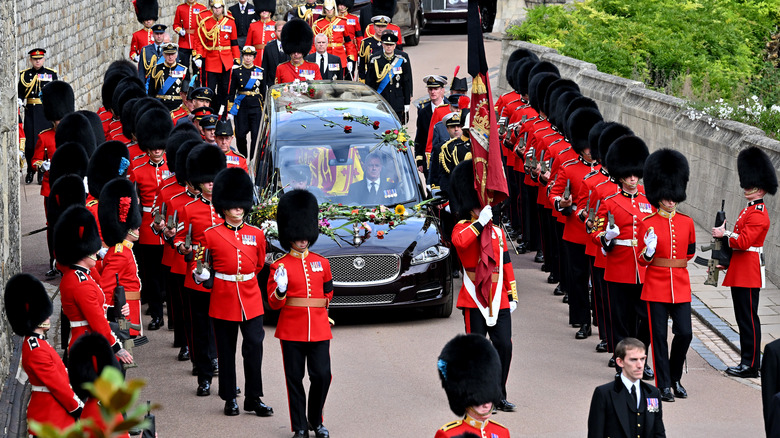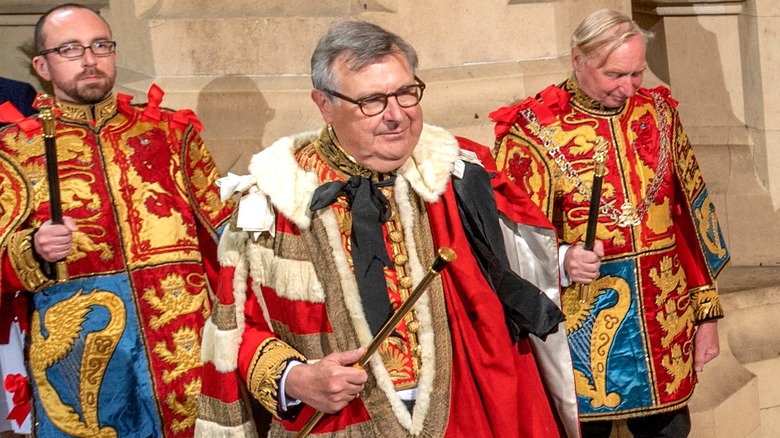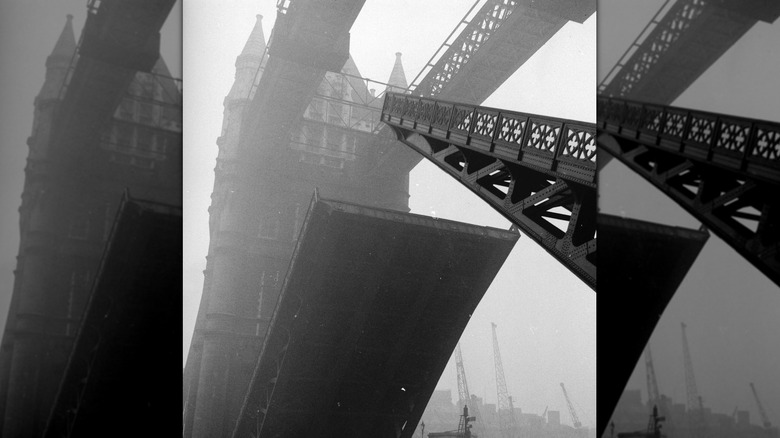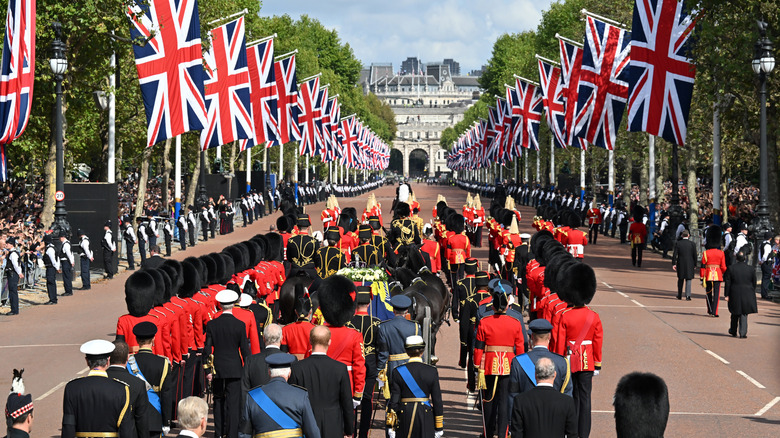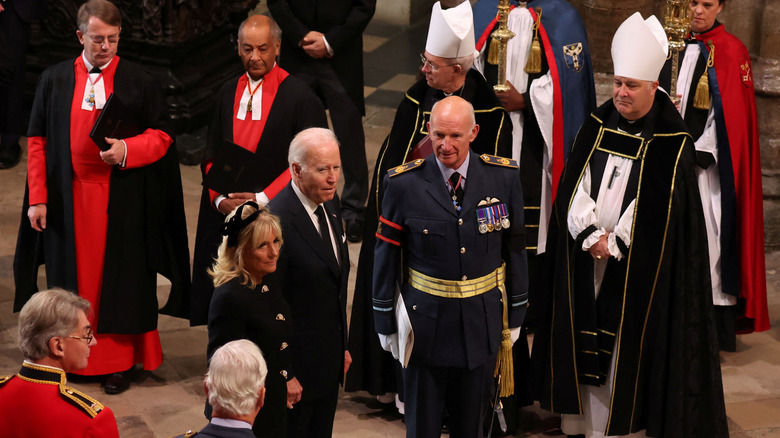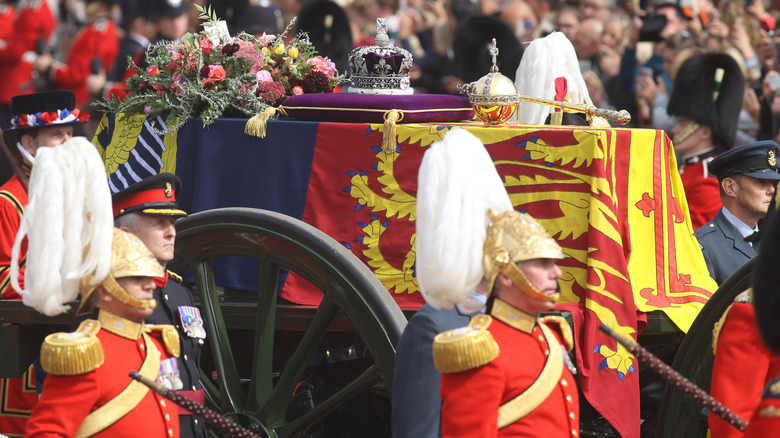What It Was Like To Prepare For Queen Elizabeth II's Funeral
Stability is one of the biggest selling points of monarchy. It's a guarantor of succession — a straightforward way of handing the reins from one leader to the next (assuming, of course, there's an undisputed heir and no conflicts like the Wars of Roses). In a constitutional monarchy, the hereditary principle keeps the chaos of politics out of the ostensibly nonpolitical role played by the monarch as head of state. And if a monarch takes the throne when young and enjoys a long life, as Queen Elizabeth II of Britain did, the nation will have a leader who endures through elections, crises, triumphs, and the rise and fall of at least a few generations.
But kings and queens aren't immune to the ravages of time. They may provide a stabilizing element to their nations, to the point of being seen as a perennial figure, but sooner or later, their clock runs out. Elizabeth's ran out in 2022, after a reign of over 70 years that saw her frequently hailed as a capable and popular head of state, not only in the U.K. and the Commonwealth realms, but around the world. Given her age (96 at her death) and declining health, her passing was long anticipated as a possibility, but when the day came, it was no less a sorrowful time for many Britons.
Tasked with managing the funeral for the beloved monarch was Edward Fitzalan-Howard, 18th Duke of Norfolk. He had years of preparation and ages of precedent — ceremony being another stabilizing aspect of monarchy — but a strong public sentiment to match as well. Here's how the duke got the job and what went into his preparations for the queen's funeral.
The Dukes of Norfolk have planned royal ceremonies for centuries
Edward Fitzalan-Howard is not only the Duke of Norfolk. He's also the earl marshal, one of the great officers of state in the United Kingdom and one of the few such titles to still play an active role in British affairs. Originally concerned with managing the royal horses, the office later took on responsibilities for the College of Arms and state ceremonies, in a sense taking over the duties of medieval heralds. In the former role, the earl marshal is responsible for granting new arms. In the latter role, they must supervise state openings of Parliament, coronations, and state funerals — like Queen Elizabeth II's.
The office of earl marshal was traditionally given to the highest-ranking duke in England, and the Howard family holding the dukedom first took up the job in 1483. The earl marshal was coupled to the dukedom by hereditary right in 1672, meaning they've been planning coronations and funerals ever since. It's a job that has, at certain points in history, been complicated by the fact that the Howards have remained a Catholic, rather than an Anglican, family.
Before Elizabeth's death, the last time the duke of Norfolk had to arrange a funeral for a reigning monarch was in 1952, with the death of George VI. The duke at the time was Bernard Marmaduke Fitzalan-Howard, the 16th duke of Norfolk. He was also responsible for Winston Churchill's funeral and Elizabeth's coronation.
[Featured image by Annabel Moeller via Wikimedia Commons | Cropped and scaled | CC BY-2.0]
The queen's funeral was in the works for years
Even a ceremonial head of state is an important figure to a national government, and one who necessitates various contingencies. Queen Elizabeth II's death was planned for well before the day it arrived. Under the vaguely Bondian codename of Operation London Bridge, most plans for the immediate aftermath of her death envisaged her dying in the way she ultimately did, surrounded by family and medical staff after an illness. The process provided for the notification of the British prime minister and public and the transport of the queen's body to London.
There were other ready plans and codenames. Operation UNICORN was devised if, as it happened, the queen died at her beloved Balmoral Castle in Scotland rather than in England. Operations MARQUEE and FEATHER were drawn up to cover the logistics of Elizabeth's lying in state, both the ceremonial aspects and the handling of the public as they came to pay their respects. And encompassing all these plans was Operation LION, meant to provide a general roadmap for the death of any member of the royal family.
The framework for these operations was refined under Edward Fitzalan-Howard, who inherited responsibility for planning royal occasions such as funerals back in 2002. Prior to his becoming duke of Norfolk, his father had left plans for the queen's funeral loose, assuming that a man of his wartime experience could quickly arrange and coordinate them on short notice. The duke presented his heavily expanded plans to the then-Prince of Wales for approval in 2015.
There was little time to prepare
To aid him in preparing for Queen Elizabeth II's funeral, Edward Fitzalan-Howard had family history and connections to draw from. Upon becoming duke, he consulted with Lieutenant Colonel Anthony Mather, an expert on ceremony who had participated in the funerals of Winston Churchill and Louis Mountbatten. When it came time to execute the plans, he had Major General Chris Ghika of the Household Division of the British Army and Garrison Sergeant Major Andrew Vern Stokes. They had plenty of documentation and tradition to guide them.
But the queen's death, while not unexpected, came only a day after the duke was notified that the funeral plans would be needed. When the arrangements were activated, he and his team found major elements weren't ready. The state trumpeters and members of the Queen's Company of Grenadier Guards meant to act as her bearer party were all out of the country and had to be hastily recalled. There was only time for one rehearsal, and those participating initially treated it more as a reunion than practice for a solemn ceremony of state. The rehearsal itself was full of disasters.
And tradition could only provide so much guidance. To accommodate expected attendance, the duke chose to move the funeral to Westminster Abbey rather than Windsor Castle. And scheduling and security meant that the queen's body couldn't return to London from Scotland by train, which typically allows those along the route to pay their respects at stations.
Attending world leaders had to ride the bus
Queen Elizabeth II was a constitutional monarch. While theoretically possessing considerable reserve powers, she could not and did not use them except on the advice of government officials. But in her ceremonial role as head of state, she met scores of world leaders over the years, and many came to pay their respects at her funeral.
Managing so many dignitaries and heads of government was part of Edward Fitzalan-Howard's job as earl marshal. The sheer number of them posed a logistical problem for the duke. It wasn't possible, given the short time frame available to him, to accommodate every delegation arriving and departing by their own transport. The solution? Bus them in. World leaders were obliged to share coaches to Westminster Abbey, an arrangement that allegedly upset French President Emmanuel Macron's delegation. The French were even more upset that U.S. President Joe Biden was exempted from the bus plan. But the team behind the funeral didn't have a choice — U.S. security refused to let him ride a vehicle they didn't approve of.
By taking his special bomb-proof limousine, Biden arrived late to the funeral and was obliged to wait until a procession of British veterans passed ahead of him. Prime seats belonged to the governors-general of the Commonwealth realms, followed by elected Commonwealth leaders. Other heads of state were placed in alphabetical order, which meant France had a better seat than the U.S.
The earl marshal had to take charge during the funeral procession
There were three processions making up Queen Elizabeth II's funeral on September 19, 2022. The first went by almost without a hitch. The lines behind the coffin fell off-beat at one point, but Garrison Sergeant Major Vern Stokes managed to get things back on track. The ceremony itself was well-executed, though it ran long by two minutes. But when it came time to bear the coffin away, a miscalculation found during rehearsal came back to haunt Earl Marshal Edward Fitzalan-Howard.
The coffin was carried from Westminster on a gun carriage, pulled by sailors whose average pace was estimated at 1.5 feet. The schedule for the funeral parades was based around a guardsman's pace of 2.5 feet, which would put the coffin well behind the front of the procession. There wasn't time to revise the schedules — all the planning team could do was hope to make up the time somewhere. The coffin ended up arriving 32 minutes late to the hearse that would take it to Windsor Castle. When talk began that the last leg of the funeral would have to be delayed by a half-hour, the duke took charge.
At the duke's insistence, a lunch break was cut short. He herded the front marchers, some of whom hadn't had a bathroom break, back into place as the hearse arrived. Back on schedule, the last parade took off and arrived at Windsor Castle on time.
